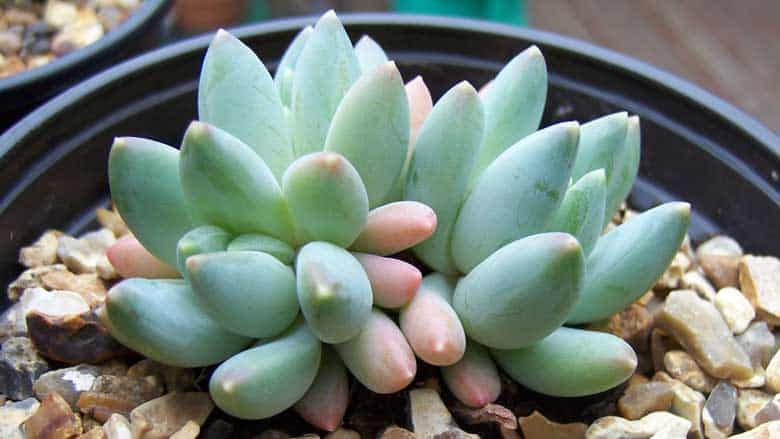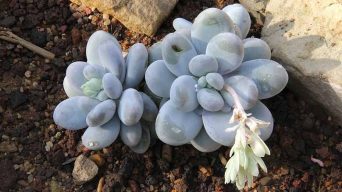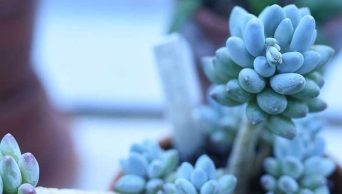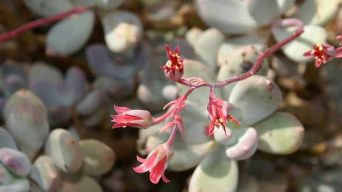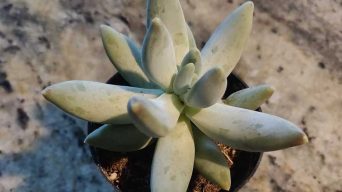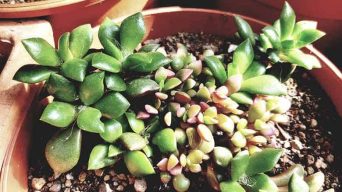Pachyphytum compactum ‘Little Jewel’ can be grown indoors or outdoors, as well as in containers or garden beds, making it perfect for any space!
If you’re looking for something easy that will thrive without much care, then this is your perfect match!
They’re easy enough for anyone who’s not too knowledgeable about gardening yet still provide plenty of benefits for those who know what they’re doing!
Learn how to propagate the Pachyphytum compactum plant, as well as how to take care of it. This guide will help you grow a healthy and beautiful garden!
Overview
Pachyphytum compactum, commonly known as Little Jewel, is a perennial succulent plant from the Crassulaceae family, native to Mexico.
This Pachyphytum species is a type of succulent with short stems. It grows up to 6 inches (15 cm) long and often branches towards the base.
It holds rosettes with cylindrical fleshy leaves that are up to 1.2 (3 cm) inches long and light green-grey color with white veins and purple tips.
The flowers are a muted yellow in the center with an orange border. The inflorescence reaches 1 foot (30 cm) high and blooms from late winter to early spring.
How To Care for Pachyphytum Compactum
Pachyphytum compactum care is similar to Pachyphytum oviferum and Pachyphytum bracteosum care.
Below you’ll find the most important information you need to know about caring for Pachyphytum compactum.
Sun Exposure & Light Requirements
The Pachyphytum compactum succulent plant is easy to grow but grows slowly and requires plenty of light.
They thrive in either full sun or partial shade but will burn their leaves if they get too much intense sunlight.
Pachyphytum plants prefer diffused bright light conditions when grown indoors.
You do not want to put them in direct sunlight, but you should place them somewhere where they will get lots of indirect light from the sun.
An ideal place would be a north-facing window where it gets plenty of sunlight during the morning but will not get direct sunlight for the rest of the day.
When grown outdoors, you should provide them with some shade during the hottest part of the day.
You can do this by placing a tree or building your own shade structure if you have the time and know-how.
Watering Requirements
The watering requirements of the Pachyphytum compactum succulent plant are not very demanding.
When watering this plant, you should allow the soil to dry out before adding more and avoid overwatering. Too much water is harmful to the plant; you should always allow it to dry out before watering.
When watering, avoid getting water on the leaves, and you should water in the morning or afternoon but not during the hottest hours of the day.
Soil Requirements
The Pachyphytum compactum needs well-draining soil like cactus soil, or you can make your succulent potting mix.
The main ingredient of the soil should be comprised of pumice, perlite, sand, or peat moss. The soil you use should hold the moisture and provide good drainage.
The best succulent potting mix you can use is a mixture of 2 parts coarse sand and 1 part pumice for the soil.
The succulents need a more porous soil mix to allow the water to reach all the root systems of the plants.
Temperature and Humidity
Temperature is vital to the health of your Pachyphytum compactum. You must make sure you do not over or underheat your plant.
The Pachyphytum needs a temperature range of 68° – 80° Fahrenheit (20°-27° Celsius) during the day and around 50° – 70° Fahrenheit (10°-21° Celsius) at night.
It should be on the cooler end during the day and somewhere in the middle of the night so you can maintain a temperature gradient within your plant’s enclosure.
Humidity is just as important as temperature. Where you live will determine your humidity requirements.
The Pachyphytum compactum needs around 40% relative humidity or more.
Make sure you do not overwater your plant, as this can create very high humidity, and you will need to change your environment to keep the levels down.
Creating the right conditions for your Little Jewel succulent is challenging, but you must strive to find that perfect balance.
Fertilizing
The soil you use for your Pachyphytum compactum should be organic, and you can add some fertilizer to the soil, but you don’t need it.
The best way to fertilize your plant is to apply a liquid fertilizer once a month during the growing season. Use a diluted form of 20-20-20 or 30-30-30.
A general rule of thumb is to fertilize your plant with about half the strength you use on a regular houseplant.
You do not want to over-fertilize your Pachyphytum compactum.
Potting and Repotting
The Pachyphytum compactum succulent does not require you to repot the plant too often. It should be repotted approximately every two years, preferably in spring.
This will ensure a healthy and happy Pachyphytum plant in your garden or inside your house.
The best type of pot you should get for your Pachyphytum compactum is a clay pot with good drainage. This will allow you to prevent the plant from overwatering, and you do not have to worry about it drowning in its own soil.
If you repot your succulent, you need to make sure you remove any excess soil.
Then you have to give the plant a good watering, letting the water soak through the roots.
Let the soil dry out slightly before you water again.
Pruning
Pruning a Pachyphytum compactum is unnecessary; you only need to give it some basic care to survive.
Look for any leaves which have withered or died, and remove them from the plant at all costs. This will ensure good growth in the future without dry patches appearing on your succulent plant.
In addition, you will also need to maintain its health by removing any dead or dying stems you might encounter.
Pests and Diseases
Pachyphytum Compactum succulent plants attract a few pests and diseases.
You will most likely only need to worry about maintaining your plant’s health, and you won’t be bothering much with pests and diseases.
The best way to deal with this is to remove the problem area before it spreads or causes any other damage.
The most common problems that you may come across when dealing with Pachyphytum Compactum are:
- Infestation – generally due to overwatering, which can create an environment that attracts aphids, mealy bugs, mites, or scale insects (insects who suck on your plant’s juices)
- Root Rot (disease) – generally found in over-watered plants, you should never let your Pachyphytum Compactum plant stand in water for a long period.
- Fire Blight (infection) – starts as brownish/yellow spots on your leaves and can eventually turn the whole leaf brown.
- Cercospora Leaf Spot (disease) – you will start to notice circular yellow and brown spots on your leaves.
- Yellow Leaf Spot (disease) – you will start to notice yellow and brown spots on your leaves.
- Powdery Mildew (fungus) – you will start to notice a white powder-like spore on your plant’s leaves. Generally, you’ll see this problem on Pachyphytum Compactum plants in damp conditions, and you can easily remove it with rubbing alcohol.
If you notice any of these problems, you should identify the problem. Then you will need to remove them before they can cause any other damage to your plant.
To ensure that you don’t attract these pests and diseases, you must keep your plant healthy at all times; by watering correctly and providing enough air circulation around your succulents.
How to Care for Pachyphytum Compactum in Winter
The Pachyphytum compactum plant needs you to care for it during wintertime, especially if you live in places where temperatures fall below 50ºF (10°C) during the whole season.
Location
Your plant will need bright light during wintertime.
Choose a place near a window that you have opened often. That way, your plant will get enough light all day long.
You do not want too much light, either, because it will make your plants wither faster because of the changes in temperature inside your home.
Temperature
Until you know your plant can survive temperatures below 50°F (10°C), you should keep it in a place with temperatures of about 5 to 10 degrees higher than that.
This will make your plants still have enough growing energy during the wintertime, and you won’t have to worry about them withering or drying out quickly.
Watering the Plant During Winter
During winter, you’ll need to water your plant less than you did during the summer.
Depending on your plant’s growth, you should water it once a month or less if you can.
Be sure not to overwater your plants, and you don’t have to worry about giving them nutrients as well because you’ve given them enough light, they should be alright.
Artificial Lighting
If you’re worried that your plants won’t get enough light, you can use artificial lighting throughout the wintertime.
Make sure you use one that covers the amount of light you need for your plants to grow.
If you have more than one plant, you should get a light that can cover the amount of light you need for your entire collection of Pachyphytum compactum.
Fertilizer
Make sure you don’t give your plants any fertilizer during winter.
If you can, you should also avoid giving them nutrients when you water your plants as well.
This might either cause your plant to die out or wither quickly due to the cold weather you’re exposing it to.
How To Propagate Pachyphytum Compactum
Pachyphytum compactum succulents can be easily propagated by leaf cuttings.
How To Propagate By Leaf Cuttings
The easiest way to propagate your Pachyphytum compactum succulent is by leaf cuttings.
The ideal time of year for you to do this would be in the spring or even during the fall months, but you could also propagate your succulents through leaf cuttings during the summer.
To do this, you will need to remove the leaf you’d like to propagate from the mother plant, and then you’ll allow it to callous for a few days.
Then you’ll need to place your leaf cutting in well-draining soil, and you can mist the soil, but you will have to be sure that you allow adequate drainage.
It can take some time for your succulent to grow roots. You will need to be patient as they’ll form in time.
When you have your succulent with a nice little sprout, you can transplant it into a larger pot and place it in a sunny location.
You’ll have your succulent for years to come!
Is the Pachyphytum Compactum Toxic?
The Pachyphytum compactum is not toxic to people or animals.
However, after handling your plant, make sure you wash your hands to avoid possible irritation.
Final Thoughts
Pachyphytum compactum plants are ideal for gardeners who want something easy to care for and drought tolerant.
They can be grown in containers or as ground cover on slopes or hillsides where other plants won’t grow well due to poor soil conditions.
They also make excellent houseplants because they thrive indoors without direct sunlight, making them perfect for those living in apartments or condos with limited space outside their homes.

